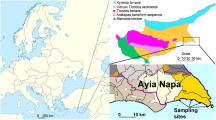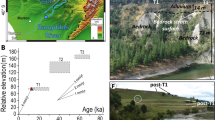Abstract
This study focuses on the younger of a series of Quaternary terraces along the flanks of the Kyrenia Range in northern Cyprus, specifically the Kyrenia (Girne) and the Koupia terraces. The Kyrenia (Girne) terrace is tentatively correlated with oxygen isotope stage 5 (125 Ka), and the Koupia terrace with oxygen isotope stage 3 (<50 Ka). Along the northern flank of the range, the Kyrenia (Girne) terrace deposits (5–20 m above modern sea level) typically begin with a basal lag conglomerate and then pass upwards into shallow-marine calcarenites and then into variable aeolianites, paleosols and fluvial deposits (up to 20 m thick). In contrast, the Koupia terrace (<2 m above modern sea level) consists of aeolianites and shallow-marine calcarenites (up to 8 m thick). The equivalent deposits along the southern flank of the range are entirely non-marine fluvial mud, sands and conglomerates. The marine to continental terrace systems can be tentatively correlated based on mapping, height above modern sea level and sedimentary facies. However, variable preservation and patchy exposure require such correlations to be independently tested. To achieve this, a portable optically stimulated luminescence (OSL) reader was used to determine the luminescence characteristics of the two terrace systems. Luminescence profiles show major differences in luminescence characteristics between the two terrace depositional systems, which can be related to sedimentary processes, provenance and age. These features allow sections in different areas to be effectively correlated. Individual sections show luminescence properties that are generally consistent with an expected up-sequence decrease in age. However, the younger Koupia terrace deposits show higher luminescence intensities compared with the older Kyrenia (Girne) terrace deposits. This can be explained by multiple phases of reworking of the Kyrenia (Girne) terrace deposits, which changed the luminescence characteristics of the sediment. The use of the portable OSL reader is therefore an effective means of correlating Late Quaternary terrace deposits in northern Cyprus and probably also elsewhere.













Similar content being viewed by others
References
Bagnall PS (1960) The Geology and Mineral Resources of the Pano Lefkara-Larnaca Area. Geol. Surv. Depart. Cyprus, Memoir, 5, 116
Baroz F (1979) Étude géologique dans le Pentadaktylos et la Mesaoria (Chypre Septentrionale). Earth Sciences. Nancy, Université de Nancy. Unpubl. PhD thesis
Burbidge CI, Sanderson DCW, Housley RA, Allsworth JP (2007) Survey of Palaeolithic sites by luminescence profiling, a case study from Eastern Europe. Quat Geochronol 2(1):296–302
Constantinou G (1995) Geological map of Cyprus. Technical report, Geol SurDept, Cyprus
Cosentino D, Schildgen TF, Cipollari P, Faranda C, Gliozzi E, Hudácková N, Lucifora S, Strecker MR (2011) Late miocene surface uplift of the Southern margin of the central anatolian plateau, central taurides, Turkey. Geol Soc Am Bull 124:133–145
Dilek Y, Sandvol E (2009) Seismic structure, crustal architecture and tectonic evolution of the Anatolian–African Plate Boundary and the Cenozoic Orogenic Belts in the Eastern Mediterranean Region. In Murphy JB, Keppie JD, Hynes AJ (eds) 2009. Ancient Orogens and Modern Analogues. Geol Soc London, Spec Publ. 327:127–160
Dreghorn W (1978) Landforms in the Girne Range Northern Cyprus. Ankara, Maden Tetkik ve Arama Enstitüsü, Ankara, Turkey
Ducloz C (1963) Geological map of the Central Kyrenia Range. Geol Surv Dept., Cyprus
Ducloz C (1964) Revision of the pliocene and Quaternary stratigraphy of the central Mesaoria. The Cosmos Press Ltd, Nicosia Cyprus, Nicosia
Ducloz C (1972) The geology of the bellapais-kyrthrea area of the central Kyrenia range. Bull. 6. Geol Surv Dept Nicosia, Cyprus
Durcan JA, Roberts HM, Duller GAT, Alizai AH (2010) Testing the use of range-finder OSL dating to inform field sampling and laboratory processing strategies. Quat Geochronol 5(2):86–90
Frébourg G, Hasler C-A, Guern PL, Davaud E (2008) Facies characteristics and diversity in carbonate eolianites. Facies 54(2):175–191
Garzanti E, Andò S, Scutellà M (2000) Actualistic ophiolite provenance: the Cyprus case. J Geol 108:199–218
Göğüş OH, Pysklywec RN (2008) Mantle lithosphere delamination driving plateau uplift and synconvergent extension in eastern Anatolia. Geology 36(9):723–726
Harrison RW, Newell WL (2004) Tectonic framework and late Cenozoic tectonic history of the northern part of Cyprus: implications for earthquake hazards and regional tectonics. J Asian Earth Sci 23:91–210
Harrison RW, Tsiolakis E, Stone BD, Lord A, Mcgeehin JP, Mahan SA, Chirico P (2012) Late pleistocene and holocene uplift history of Cyprus: implications for active tectonics along the southern margin of the Anatolian microplate. In: Robertson AHF, Parlak O, Ünlügenç UC (eds) 2012. Geological development of Anatolia and the Easternmost Mediterranean Region. Geol Soc London Spec Publ 372(1):561–584
Henson FRS, Browne RV, McGinty J (1949) A synopsis of the stratigraphy and geological history of Cyprus. Q J G S 105:1–41
Jaffey M, Robertson AHF (2004) Non-marine sedimentation associated with oligocene-recent exhumation and uplift of the Central Taurus Mountains, S. Turkey. Sedim Geol 173:53–89
Kempler D, Ben-Avraham Z (1987) The tectonic evolution of the Cyprean Arc. Ann Tecton 1:58–71
Kinnaird T, Robertson AHF (2013) Tectonic and sedimentary response to subduction and incipient continental collision in southern Cyprus, easternmost Mediterranean region. In: Robertson AHF, Parlak O, Ünlügenç UC (eds) 2013. Geological Development of Anatolia and the Easternmost Mediterranean Region. Geol Soc Lond Spec Pub 372(1):585–614
Kinnaird TC, Robertson AHF, Morris A (2011) Timing of uplift of the troodos massif (Cyprus) constrained by sedimentary and magnetic polarity evidence. J Geol Soc London 168:457–470
Kinnaird TC, Sanderson D, Woodward N (2012) Applying luminescence methods to geo-archaeology: a case study from Stronsay, Orkney. Trans R Soc Edinburgh Earth Sci 102:191–199
Knupp C (1964) Geological map of the Central Kyrenia Range. Geol Surv Dept. Nicosia, Cyprus
Leeder MR, McNeill LC, Collier REL, Portman C, Rowe PJ, Andrews JE (2003) Corinth rift margin uplift: new evidence from late quaternary marine shorelines. J Geophy Res 30(12):1611
Lian OB, Roberts GR (2006) Dating the Quaternary: progress in luminescence dating of sediments. Quatern Sci Rev 25(19–20):2449–2468
McCallum JE, Robertson AHF (1995a) Sedimentology of the two fan-delta systems in the Pliocene-Pleistocene of the Mesaoria Basin Cyprus. Sed Geol 98:215–244
McCallum JE, Robertson AHF (1995b) Late Miocene-Early Pleistocene Athalassa Formation, north central Cyprus: carbonate sand bodies in a shallow seaway between two emerging landmasses. Terra Nova 7:265–277
McCay GA, Robertson AHF (2012) Sedimentology and provenance of Upper Eocene-Upper Miocene clastic sediments of the Girne (Kyrenia) Range, northern Cyprus: a case history of sedimentation related to progressive and diachronous continental collision. Sed Geol 265:30–55
McCay GA, Robertson AHF, Kroon D, Raff I, Ellam RM, Necdet M (2012) Stratigraphy of cretaceous to lower pliocene sediments in the northern part of Cyprus based on comparative 87Sr/86Sr isotopic nannofossil and planktonic foraminiferal dating. Geol. Mag. 1–27
Moshkovitz S (1966) The age of the Kyrenia Formation in Cyprus 2. In: International Union of Geologial Sciences, Proc. 3rd Session, Berne 303
Muñoz-Salinas E, Bishop P, Sanderson DCW, Zamorano J-J (2011) Interpreting luminescence data from a portable OSL reader: three case studies in fluvial settings. Earth Surf Proc Land 36:651–660
Munyikwa K, Brown S, Kitabwalla Z (2012) Delineating stratigraphic breaks at the bases of postglacial eolian dunes in central Alberta, Canada using a portable OSL reader. Earth Surf Proc Land 37(15):1603–1614
Necdet M, Anıl M (2006) The geology and geochemistry of the gypsum deposits in Northern Cyprus. Geosound (Yerbilimleri) 48–49:11–49
Palamakumbura RN (2015) Sedimentary, geomorphological and dating evidence for the uplift of the Kyrenia Range, northern Cyprus: testing alternative regional tectonic models. Unpublished PhD thesis. University of Edinburgh
Pietsch TJ, Olley JM, Nanson GC (2008) Fluvial transport as a natural luminescence sensitiser of quartz. Quat Geochronol 3(4):365–376
Poole A, Robertson AHF (1991) Quaternary uplift and sea-level change at an active plate boundary, Cyprus. J Geol Soc London 148(5):909–921
Poole AJ, Robertson AHF (1998) Pleistocene fanglomerates deposition related to uplift of the Troodos Ophiolite, Cyprus. In: Robertson, A.H.F., Emeis, K.-C., Richter, C., Camerlenghi, A. (eds), Proc ODP Scientific Results. 160:544–568
Poole AJ, Robertson AHF (2000) Quaternary marine terraces and aeolianites in coastal south and west Cyprus: implications for regional uplift and sea-level change. In: Panayides I. Xenophontos C., Malpas J (eds). Proc 3rd Internat Conf on the geology of the Eastern Mediterranean. Cyprus Geol Surv. Dert Nicosia, Cyprus
Poole A, Shimmield G, Robertson AHF (1990) Late Quaternary uplift of the Troodos ophiolite, Cyprus: uranium-series dating of Pleistocene coral. Geology 18:894–897
Reed FR (1930) Contributions to the geology of Cyprus. Geol Mag 76(06):241–271
Reed FR (1935) Notes on the neogene faunas of Cyprus. The pliocene faunas. J Nat Hist 16(95):489–524
Rhodes EJ (2011) Optically stimulated luminescence dating of sediments over the past 200,000 years. Ann Rev Earth Planet Sci 39:461–488
Roberts HM, Duller GA (2004) Standardised growth curves for optical dating of sediment using multiple-grain aliquots. Radiat Meas 38(2):241–251
Roberts HM, Durcan JA, Duller GA (2009) Exploring procedures for the rapid assessment of optically stimulated luminescence range-finder ages. Radiat Meas 44(5):582–587
Robertson AHF (1990) Tectonic evolution of Cyprus. In: Malpas J, Moores E, Panayiotis A, Xenophontos C. Ophiolites-oceanic crustal analogues. ProcSymp ‘Troodos 1987′, Geol Surv Depart, Cyprus, 235–253
Robertson AHF (1998) Tectonic significance of the Eratosthenes Seamount: a continental fragment in the process of collision with a subduction zone in the eastern mediterranean (Ocean drilling program leg 160). Tectonophysics 298:63–82
Robertson AHF (2000) Tectonic evolution of Cyprus in its Easternmost Mediterranean setting. In: Panayides I, XenophontosC, Malpas J. (Eds), Proc 3rd Internat Conf on the Geology of the Eastern Mediterranean, Geoll SurvDept Cyprus, 11–44
Robertson AHF, Woodcock NH (1986) The role of the Kyrenia Range Lineament, Cyprus, in the geological evolution of the Eastern Mediterranean area. Phil. Trans. R. Soc. London. Series A, Mathematical and Physical Sciences, In: Reading HG, Watterson J, White, SH. 1987. Major Crustal Lineaments and their influences on the Geological History of Continental Lithosphere 317 (1539):141–177
Robertson AHF, Tasli K, İnan N (2012) Evidence from the Kyrenia Range, Cyprus, of the northerly active margin of the Southern Neotethys during Late Cretaceous-early Cenozoic time. Geol Mag 149(02):1–27
Robertson AHF, McCay GA, Taslı K, Yıldız A (2014) Eocene development of the northerly active continental margin of the Southern Neotethys in the Kyrenia Range, north Cyprus. Geol Mag 151(4):692–731
Sanderson DCW, Murphy S (2010) Using simple portable OSL measurements and laboratory characterization to help understand complex and heterogeneous sediment sequences for luminescence dating. Quat Geochronol 5:299–305
Sanderson DCW, Bishop P, Houston I, Boonsener M (2001) Luminescence characterisation of quartz-rich cover sands from NE Thailand. Quatern Sci Rev 20(5):893–900
Sanderson DCW, Bishop P, Stark MT, Spencer JQ (2003) Luminescence dating of anthropogenically reset canal sediments from Angkor Borei, Mekong Delta, Cambodia. Quatern Sci Rev 22(10):1111–1121
Schildgen TF, Cosentino D, Bookhagen B, Niedermann S, Yıldırım C, Echtler H, Wittmann H, Strecker MR (2012) Multi-phased uplift of the Southern margin of the central anatolian plateau, Turkey: a record of tectonic and upper mantle processes. Earth Planet Sci Lett 317–318:85–95
Hakyemez Y, Turhan N, Sönmez, İ, Sümengen M (2000) Kuzey Kıbrıs Türk Cumhuriyeti’ nin Jeolojisi, MTA. Genel Müdürlüğü Jeoloji Etütleri Diaresi, Ankara: 44
Weber J, Schirmer W, Heller F, Bachtadse V (2011) Magnetostratigraphy of the Apalós Formation (early Pleistocene): evidence for pulsed uplift of Cyprus. Geochemistry, Geophysics, Geosystems 12 (1)
Weiler Y (1970) Mode of occurrence of pelites in the Kythrea Flysch Basin (Cyprus). J Sed Petrol 40:1255–1261
Zomeni Z (2012) Quaternary marine terraces on Cyprus: constraints on uplift and pedogenesis, and the geoarchaeology of Palaipafos. Unpublished PhD thesis. Oregon State University
Author information
Authors and Affiliations
Corresponding author
Rights and permissions
About this article
Cite this article
Palamakumbura, R.N., Robertson, A.H.F., Kinnaird, T.C. et al. Sedimentary development and correlation of Late Quaternary terraces in the Kyrenia Range, northern Cyprus, using a combination of sedimentology and optical luminescence data. Int J Earth Sci (Geol Rundsch) 105, 439–462 (2016). https://doi.org/10.1007/s00531-015-1173-3
Received:
Accepted:
Published:
Issue Date:
DOI: https://doi.org/10.1007/s00531-015-1173-3




